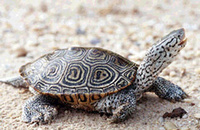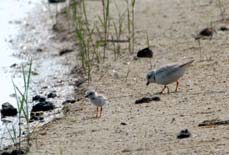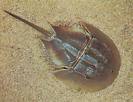- Coastal Elevations
- Ocean Coasts
- Wetland Accretion
- Societal Impacts
- Adaptation
- Elevation Maps
- Planning Maps
Vulnerable Species
Related Links
U.S. Global Change Research Program
Other EPA-sponsored Climate Change Science Program Synthesis and Assessment Reports
By Ann Shellenbarger Jones, Christina Bosch, and Elizabeth Strange
Vulnerable Species (14 pp, 8.6MB)
was originally published as
Chapter 5 of the US Climate Change Science Program's Synthesis and Assessment Product 4.1.
A reasonable way of citing this paper would be:
Shellenbarger Jones, A., C. Bosch, and E. Strange, 2009: Vulnerable species: the effects of sea-level rise on coastal
habitats. In: J.G. Titus (coordinating lead author),
K.E. Anderson, D.R. Cahoon, D.B. Gesch, S.K. Gill, B.T. Gutierrez, E.R. Thieler, and S.J. Williams
(lead authors). Coastal Sensitivity to Sea-Level Rise: A Focus on the Mid-Atlantic Region.
U.S. Environmental Protection Agency, Washington DC, pp. 43-56.
Key Findings
- The quality, quantity, and spatial distribution of coastal habitats change continuously as a result of shore erosion, salinity changes, and wetland dynamics; however, accelerated rates of sea-level rise will change some of the major controls of coastal wetland maintenance. Shore protection and development now prevent migration of coastal habitats in many areas. Vulnerable species that rely on these habitats include an array of biota ranging from endangered beetles to commercially important fish and shellfish; and from migratory birds to marsh plants and aquatic vegetation.
-
 Three key determinants of future tidal marsh acreage are: (1) the capacity of the marsh to raise its surface to match
the rate of rising sea level, (2) the rate of erosion of the seaward boundary of the marsh, and (3) the availability of
space for the marsh to migrate inland. Depending on local conditions, a tidal marsh may be lost or migrate landward
in response to sea-level rise.
Three key determinants of future tidal marsh acreage are: (1) the capacity of the marsh to raise its surface to match
the rate of rising sea level, (2) the rate of erosion of the seaward boundary of the marsh, and (3) the availability of
space for the marsh to migrate inland. Depending on local conditions, a tidal marsh may be lost or migrate landward
in response to sea-level rise.
- Where tidal marshes become submerged or are eroded, the expected overall loss of wetlands would cause wetlanddependent species of fish and birds to have reduced population sizes. Tidal marshes and associated submerged aquatic plant beds are important spawning, nursery, and shelter areas for fish and shellfish, including commercially important species like the blue crab.
- Many estuarine beaches may also be lost in areas with vertical shore protection and insufficient sediment supply. Endangered beetles, horseshoe crabs, the red knot shorebird, and diamondback terrapins are among many species that rely on sandy beach areas.
- Loss of isolated marsh islands already undergoing submersion will reduce available nesting for bird species, especially those that rely on island habitat for protection from predators. Additional temporary islands may be formed as tidal marshes are inundated, although research on this possibility is limited.
- Many freshwater tidal forest systems such as those found in the Mid-Atlantic are considered globally imperiled, and are at risk from sea-level rise among other threats.
- Tidal flats, a rich source of invertebrate food for shorebirds, may be inundated, though new areas may be created as other shoreline habitats are submerged.
Summary of Impacts to Wetland-Dependant Species
 Based on currently available information, it is possible to
identify particular taxa and even some individual species
that appear to be at greatest risk if coastal habitats are
degraded or diminished in response to sea-level rise and
shoreline hardening:
Based on currently available information, it is possible to
identify particular taxa and even some individual species
that appear to be at greatest risk if coastal habitats are
degraded or diminished in response to sea-level rise and
shoreline hardening:
- Degradation and loss of tidal marshes will affect fish and shellfish production in both the marshes themselves and adjacent estuaries.
- Bird species that are marsh specialists, including the clapper rail, black rail, least bittern, Forsterís tern, willet, and laughing gull, are particularly at risk. At present, the majority of the Atlantic Coast breeding populations of Forsterís tern and laughing gull are considered to be at risk from loss of lagoonal marshes.
- Increased turbidity and eutrophication in nearshore areas and increased water depths may reduce light penetration to SAV beds, reducing photosynthesis, and therefore the growth and survival of the vegetation. Degradation and loss of SAV beds will affect the numerous organisms that feed, carry on reproductive activities, and seek shelter in seagrass beds.
- Diamondback terrapin are at risk of losing both marsh habitat that supports growth and adjoining beaches where eggs are buried.
- Many marsh islands along the Mid-Atlantic, and particularly
in Chesapeake Bay, have already been lost
or severely reduced as a result of lateral erosion and
flooding related to sea-level rise. Loss of such islands
poses a serious, near-term threat for island-nesting bird
species such as gull-billed terns, common terns, black
skimmers, and American oystercatchers.

- Many mid-Atlantic tidal forest associations may be at risk from sea-level rise and a variety of other threats, and are now considered globally imperiled.
- Shoreline stabilization structures interfere with natural erosional processes that maintain unvegetated cliff faces that provide habitat for bank-nesting birds and tiger beetles.
- Loss of tidal flats could lead to increased crowding of foraging birds in remaining areas, resulting in exclusion of many individuals; if alternate foraging areas are unavailable, starvation of excluded individuals may result, ultimately leading to reductions in local bird populations.
- Where horseshoe crabs decline because of loss of suitable beach substrate for egg deposition, there could be significant implications for migrating shorebirds, particularly the red knot, a candidate for protection under the federal Endangered Species Act. Red knot feed almost exclusively on horseshoe crab eggs during stopovers in the Delaware Estuary.
- For previous reports focused on the implications of rising sea level, go to More Sea Level Rise Reports.

 Chapter 4: Wetland Accretion
Chapter 4: Wetland Accretion
